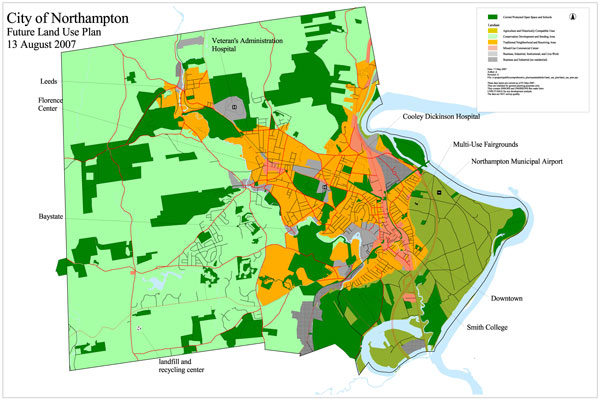Northampton’s Rezoning Subcommittee held its third meeting at Forbes Library on July 28. Its goal is to determine the optimal size and composition of a city-wide Rezoning Committee and submit a proposal to the planning board and city council. The Rezoning Committee’s decisions could have far-ranging impacts in how it chooses to implement the Sustainable Northampton Plan.
Here is a Google video that covers the entire meeting. Thanks to Owen Freeman-Daniels who shot the footage. The next meeting of the Rezoning Subcommittee will take place in Forbes Library (mezzanine level) at 5pm on Monday, August 4. The public is encouraged to attend.
During the meeting, Mr. Freeman-Daniels read a statement from the Ward 3 Neighborhood Association. Here is the text of the statement.
Statement from the Sustainability Study Group of the Ward 3 Neighborhood Association
The decision of how the Rezoning Committee will work and who will be on it is the first major step toward making significant changes to the value, look and feel of Northampton. Since changes in city regulations affect the city’s economic, environmental and demographic make-up, the Rezoning Committee will affect the city as a whole. But making this facile acknowledgement overlooks the manner of changes suggested by the Future Land Use Map and the character of the work charged to the Rezoning Committee.
The Future Land Use Map offers an image of what the future of Northampton could be and the appendix offers many regulations that may or may not guide us to such a future. The changes suggested in the appendix and reflected on the map have a general tenor: to provide ways of growing the denser areas and conserving or preserving the less-dense ones. Since most conservation and preservation involve little or no change in the status quo, it is clear that the largest and most dramatic changes coming from the Rezoning Committee will affect the denser communities.
The urban centers and traditional neighborhoods that are all around the city give Northampton a distinctive character and quality that the Sustainable Northampton Plan tries to preserve as well as grow and fill-in. If the Rezoning Committee is successful, it will have done the following: suggest a mix of regulations that provide for growth in Northampton without giving up what makes Northampton distinctive. This charge is difficult because it puts the Rezoning Committee in a constant feedback-loop with the communities it is simultaneously trying to grow and preserve. It requires both expertise and informed community representatives. This is the crux of the reasoning behind asking for both city officials and community representatives. A Rezoning Committee that doesn’t give community representatives full voting power risks being unresponsive to the balance of interests that is required for maintaining Northampton’s unique character.
The Rezoning Committee will be dealing with large and difficult issues and cannot also be required to build consensus among economic, environmental and social groups about what makes them distinctive and worth preserving. Nor can the Rezoning Committee assume to know the right balance. Instead, these groups must be allowed to build their own consensus and provide a representative to the Rezoning Committee who holds the balance sheet of their opinions. The Ward 3 Neighborhood Association’s Sustainable Northampton Study Group has prepared a plan [link] that calls on communities within the city to send nominations for their representative: the business community, environmental groups, the neighborhoods.
Therefore, we strongly urge this committee to consider our proposal.
Sincerely,
The Ward 3 Sustainability Study Group
See also:
Proposed Future Land Use Map (PDF)
The orange zones are “Traditional Neighborhood and Receiving Areas”. The light green zones are “Conservation Development and Sending Areas”.
